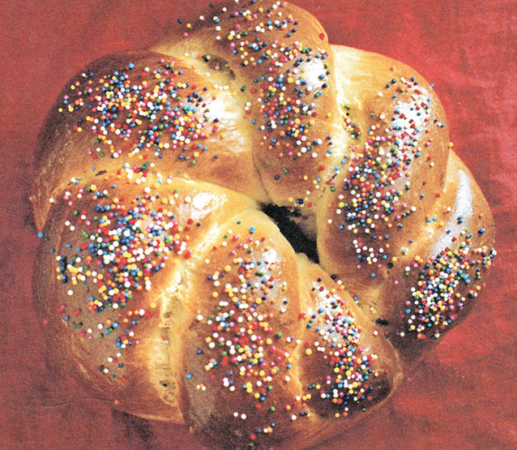Families share many Easter traditions. Easter in a home with people who trace their ancestry to Italy will likely feature “Pane di Pasqua,” which translates to “Easter Bread.”
Easter Bread is a ring of sweet bread that can be adorned with candy sprinkles. Some people nestle colorful hardboiled eggs within the twisted dough as well. Traditionally, Pane di Pasqua is made on Good Friday to help break the Lenten fast for Easter. The following recipe for “Pane di Pasqua” from “Feast of the Seven Fishes: A Brooklyn Italian’s Recipes Celebrating Food & Family” (Powerhouse Books) by Daniel Paterna makes enough dough to share the bread with friends and family.
Pane di Pasqua
Yields: 7 to 8 loaves
Dough
– 5 packages of dry yeast (111⁄4 teaspoons proof yeast in a 4-cup container)
– 5 pounds unbleached all-purpose flour (approximately 17 cups)
– 1 additional pound flour for adding to dough if needed, cleaning hands, and dusting boards and pans
– 3 1⁄2 cups sugar
– Pinch of salt
– 1 pound salted butter, softened, plus a bit more for coating rising dough
– 24 medium to large eggs, beaten
– 2 tablespoons anisette extract
Decorating
– 6 ounces rainbow-colored nonpareil
– 3 egg yolks
– 3 tablespoons water
Combine the flour, sugar and salt in a 16-quart pot. Add the butter and mix by hand, squeezing and merging butter with the flour mixture. Add proofed yeast to the flour mixture; continue mixing ingredients.
Slowly stir in all the beaten eggs and anisette using a fork. Continue to mix until ingredients are combined and loose until dough begins to form.
Knead the dough with floured hands for approximately 45 minutes, or until it becomes smooth and elastic. Add flour to the dough if needed, or to scrape the dough off your hands and the bottom of the pot.
Once the dough is fully kneaded, leave it in the pot, lightly spread some butter over the top to keep it moist, and cover with a cloth. Leave at room temperature to rise for 8 hours or overnight. The dough is ready when it rises about 5 times its size.
When the dough has fully risen, punch it down, turn it out onto a floured surface, and form it into a ball. Cut the dough into 7 or 8 smaller dough balls using a sharp knife. Then cut each ball in half. Roll each half into strands approximately 16-inches long. To form a loaf, lay the strands side by side and cross them over at one end, offset by 3 inches.
Continue crossing one strand over the other while working the braid into a circle. The tie off can be challenging. Join the circle by tucking one end under the other, pinch the dough firmly together to seal, maintaining the twist and thickness of the loaf. Repeat with the remaining dough.
Butter and flour one 9-inch baking pan for each loaf. Place the braided loaves in individual pans and set aside, covered in a warm, draft-free place to rise for another hour until the dough rises about 30 percent more.
At this point, preheat the oven to 250 F.
When the dough has risen, place the pans into the oven for about 10 minutes, then raise the temperature to 325 F. Bake until the bread is a dark golden brown and makes a hollow sound when lightly tapped on the bottom.
Prepare the egg wash for decorating. In a small bowl, beat the 3 egg yolks with 3 tablespoons of water and set aside.
When the breads are fully baked, remove them from the oven and pan using oven mitts, then decorate immediately. Brush the egg wash onto the hot surface of each loaf and sprinkle with the colored confetti. Set the loaves to cool the racks. Slice a wedge and spread with butter.




